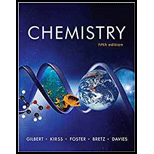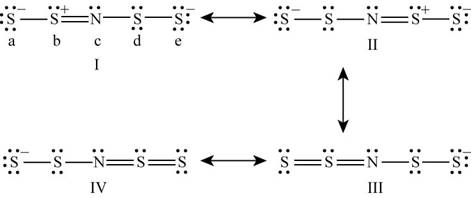
Concept explainers
Interpretation: All the resonance forms of the sulfur-nitrogen anion,
Concept introduction: Formal charges play an important role in choosing between the possible molecular structures. The preferred structure is the one in which formal charges are zero.
To determine: All the resonance forms of the sulfur-nitrogen anion,
Answer to Problem 8.90QP
Solution
All the resonance forms of the sulfur-nitrogen anion,
Explanation of Solution
Explanation
The given anion is
It is given that the atoms are arranged as

Figure 1
The atoms in the resonating structures are named as a,b,c,d and e.
The formal charge on each atom of resonating structure (I) of
Formal charge is calculated by the formula,
Number of valence electrons in
Number of lone pair electrons in
Number of bond pair electrons in
To calculate the formal charge on
Number of valence electrons in
Number of lone pair electrons in
Number of bond pair electrons in
To calculate the formal charge on
Number of valence electrons in nitrogen (c) is
Number of lone pair electrons in nitrogen (c) is
Number of bond pair electrons in nitrogen (c) is
To calculate the formal charge on nitrogen (c), substitute the value of valence electrons, lone pair electrons and bond pair electrons in the equation (1).
Number of valence electrons in
Number of lone pair electrons in
Number of bond pair electrons in
To calculate the formal charge on
Number of valence electrons in
Number of lone pair electrons in
Number of bond pair electrons in
To calculate the formal charge on
The formal charge on each atom of resonating structure (II) of
Number of valence electrons in
Number of lone pair electrons in
Number of bond pair electrons in
To calculate the formal charge on
Number of valence electrons in
Number of lone pair electrons in
Number of bond pair electrons in
To calculate the formal charge on
Number of valence electrons in nitrogen (c) is
Number of lone pair electrons in nitrogen (c) is
Number of bond pair electrons in nitrogen (c) is
To calculate the formal charge on nitrogen (c), substitute the value of valence electrons, lone pair electrons and bond pair electrons in the equation (1).
Number of valence electrons in
Number of lone pair electrons in
Number of bond pair electrons in
To calculate the formal charge on
Number of valence electrons in
Number of lone pair electrons in
Number of bond pair electrons in
To calculate the formal charge on
The formal charge on each atom of resonating structure (III) of
Number of valence electrons in
Number of lone pair electrons in
Number of bond pair electrons in
To calculate the formal charge on
Number of valence electrons in
Number of lone pair electrons in
Number of bond pair electrons in
To calculate the formal charge on
Number of valence electrons in nitrogen (c) is
Number of lone pair electrons in nitrogen (c) is
Number of bond pair electrons in nitrogen (c) is
To calculate the formal charge on nitrogen (c), substitute the value of valence electrons, lone pair electrons and bond pair electrons in the equation (1).
Number of valence electrons in
Number of lone pair electrons in
Number of bond pair electrons in
To calculate the formal charge on
Number of valence electrons in
Number of lone pair electrons in
Number of bond pair electrons in
To calculate the formal charge on
The formal charge on each atom of resonating structure (IV) of
Number of valence electrons in
Number of lone pair electrons in
Number of bond pair electrons in
To calculate the formal charge on
Number of valence electrons in
Number of lone pair electrons in
Number of bond pair electrons in
To calculate the formal charge on
Number of valence electrons in nitrogen (c) is
Number of lone pair electrons in nitrogen (c) is
Number of bond pair electrons in nitrogen (c) is
To calculate the formal charge on nitrogen (c), substitute the value of valence electrons, lone pair electrons and bond pair electrons in the equation (1).
Number of valence electrons in
Number of lone pair electrons in
Number of bond pair electrons in
To calculate the formal charge on
Number of valence electrons in
Number of lone pair electrons in
Number of bond pair electrons in
To calculate the formal charge on
Conclusion
All the resonance forms of the sulfur-nitrogen anion,
Want to see more full solutions like this?
Chapter 8 Solutions
CHEMISTRY:SCI.IN CONTEXT (CL)-PACKAGE
 ChemistryChemistryISBN:9781305957404Author:Steven S. Zumdahl, Susan A. Zumdahl, Donald J. DeCostePublisher:Cengage Learning
ChemistryChemistryISBN:9781305957404Author:Steven S. Zumdahl, Susan A. Zumdahl, Donald J. DeCostePublisher:Cengage Learning ChemistryChemistryISBN:9781259911156Author:Raymond Chang Dr., Jason Overby ProfessorPublisher:McGraw-Hill Education
ChemistryChemistryISBN:9781259911156Author:Raymond Chang Dr., Jason Overby ProfessorPublisher:McGraw-Hill Education Principles of Instrumental AnalysisChemistryISBN:9781305577213Author:Douglas A. Skoog, F. James Holler, Stanley R. CrouchPublisher:Cengage Learning
Principles of Instrumental AnalysisChemistryISBN:9781305577213Author:Douglas A. Skoog, F. James Holler, Stanley R. CrouchPublisher:Cengage Learning Organic ChemistryChemistryISBN:9780078021558Author:Janice Gorzynski Smith Dr.Publisher:McGraw-Hill Education
Organic ChemistryChemistryISBN:9780078021558Author:Janice Gorzynski Smith Dr.Publisher:McGraw-Hill Education Chemistry: Principles and ReactionsChemistryISBN:9781305079373Author:William L. Masterton, Cecile N. HurleyPublisher:Cengage Learning
Chemistry: Principles and ReactionsChemistryISBN:9781305079373Author:William L. Masterton, Cecile N. HurleyPublisher:Cengage Learning Elementary Principles of Chemical Processes, Bind...ChemistryISBN:9781118431221Author:Richard M. Felder, Ronald W. Rousseau, Lisa G. BullardPublisher:WILEY
Elementary Principles of Chemical Processes, Bind...ChemistryISBN:9781118431221Author:Richard M. Felder, Ronald W. Rousseau, Lisa G. BullardPublisher:WILEY





